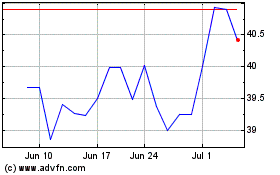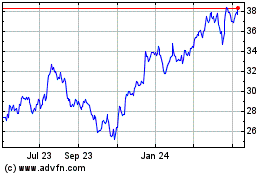Credit-Card Delinquencies Fell For Large Issuers In February
March 15 2012 - 4:48PM
Dow Jones News
Late credit-card payments fell in February for several large
banks as consumers continued to pay off bills they built up during
the holiday shopping season.
Delinquencies were down for Capital One Financial Corp. (COF),
Discover Financial Services (DFS), Bank of America Corp. (BAC),
J.P. Morgan Chase & Co. (JPM) and Citigroup Inc. (C). American
Express Co. (AXP), the largest credit-card issuer by spending, said
its delinquency rate was flat for the second-straight month at
1.4%, the lowest of the six biggest card lenders.
Credit-card performance has surged over the last two years as
many customers abstained from amassing large balances following the
recession and instead focused on paying off their loans. That trend
has helped large banks cut their bad-debt expenses, but also has
made it difficult to increase revenue, which they largely derive
from charging interest on loan balances and various account
fees.
Net charge-offs, or loans lenders deem uncollectible, also fell
for several card issuers last month. But net charge-off rates
increased for American Express, Discover and Citi.
American Express's net charge-off rate rose to 2.4% from 2.2% in
January. The rate is still down from 3.8% a year earlier and
significantly lower than a few years ago, when the rate surpassed
10%.
Discover's net charge-off rate rose to 2.8% from 2.75% in
January but is still near a historic low.
Citi's net charge-off rate increased to 5.36% from 5.27% in
January.
Bank executives have said delinquencies and charge-offs are
likely to pick up this year as the industry pursues growth, though
analysts expect performance to continue to be strong going forward.
Banks' efforts to acquire new customers and boost overall loan
balances have become more important as the financial benefits banks
have enjoyed from cutting reserves for bad loans wane.
"The chapter is closing on reserve releases," Gordon Smith, the
head of J.P. Morgan's credit-card business, said last month at the
bank's investor day.
Many banks ramped up marketing last year in an effort to steal
market share, though in recent months they have taken a breather.
For example, the volume of credit-card offers sent to customers
fell in January to 266.3 million, an 18% decline from December and
a 30% decline from a year earlier, according to Mintel
Comperemedia, a market-research firm. It was the third-straight
month of a decrease in mailings.
"We are going to have to wait and see whether" credit-card
issuers are "sort of taking stock and are going to" resume mailings
again or if it is the "beginning of an ongoing trend," said Andrew
Davidson, senior vice president with Mintel Comperemedia.
The decline could be due to issuers feeling they "don't have to
mail so much to try to seek out these customers" as consumer debt
levels rise, Davidson said.
While delinquency rates have fallen for card lenders,
credit-card expert Odysseas Papadimitriou said there is still cause
for concern. When combining the amounts of new-card debt borrowers
built up last year with the amount of bad loans that issuers
charged off, the net result suggests consumers are leveraging up at
a troubling pace, said Papadimitriou, chief executive of
CardHub.com, a credit-card comparison website.
By CardHub.com's calculation, consumer credit-card debt rose by
$47.8 billion in 2011 when including charged-off loans. That
compares with an increase of $9.1 billion in 2010 and a decrease of
$10 billion in 2009.
-By Andrew R. Johnson, Dow Jones Newswires; 212-416-3214;
andrew.r.johnson@dowjones.com
Bank of America (NYSE:BAC)
Historical Stock Chart
From Oct 2024 to Nov 2024

Bank of America (NYSE:BAC)
Historical Stock Chart
From Nov 2023 to Nov 2024
